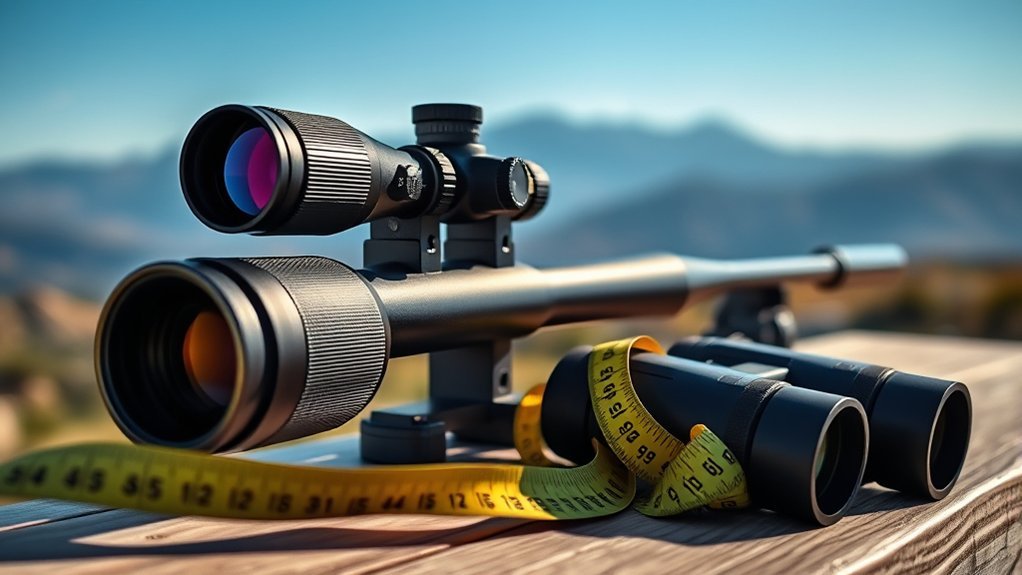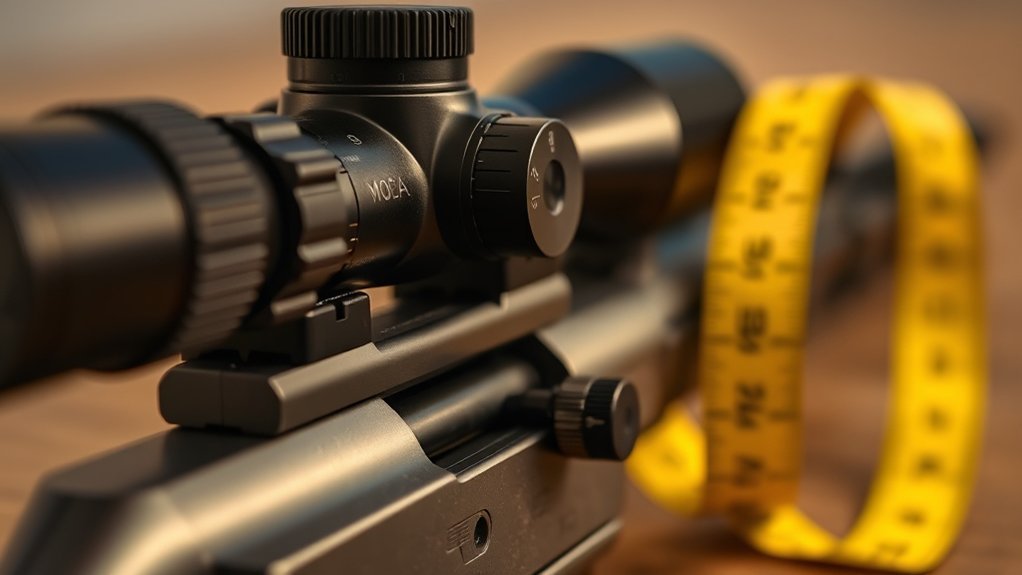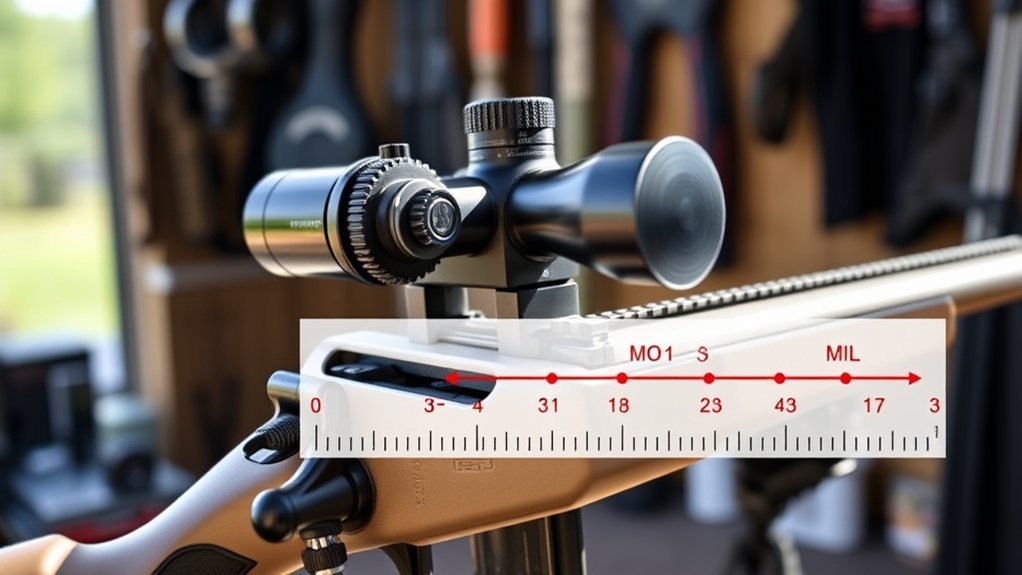When it comes to precision shooting, understanding MOA and MIL adjustments is essential for maximizing your accuracy. Each system has its unique advantages that cater to different shooting scenarios. Whether you prefer the finer adjustments of MOA or the simplified calculations of MIL, knowing how to apply these concepts effectively can greatly influence your performance. Let’s explore how each method works and when to choose one over the other.
Understanding MOA: Definition and Basics

Minute of Angle (MOA) is a crucial concept in precision shooting and firearm adjustments. It represents an angular measurement that translates to approximately 1.047 inches at 100 yards. When you adjust your scope, each click typically equals 1/4 MOA, allowing for precise corrections over distance. Understanding MOA helps you gauge bullet drop and windage more accurately. For instance, if you’re aiming at a target 300 yards away, a 3 MOA adjustment will move your point of impact roughly 9 inches. This precision is essential for achieving consistent accuracy in your shots. By mastering MOA, you enhance your shooting skills and guarantee effective engagement with targets at varying distances, making it an important aspect of your shooting proficiency.
Understanding MIL: Definition and Basics

In precision shooting, understanding MIL (Milliradian) is just as important as grasping MOA. A Milliradian is a unit of angular measurement equal to 1/1000th of a radian, allowing shooters to make precise adjustments based on distance. One MIL subtends approximately 3.6 inches at 100 yards, which provides a direct correlation between distance and adjustment. This metric system simplifies calculations, especially for those engaged in long-range shooting. When using MIL-based reticles, each hash mark typically represents one MIL, enabling you to quickly estimate range and make elevation and windage adjustments. Familiarizing yourself with MIL will enhance your shooting accuracy, ensuring you can account for factors like bullet drop and wind drift efficiently.
The Mathematical Difference Between MOA and MIL

While both MOA (Minute of Angle) and MIL (Milliradian) serve as angular measurements for making adjustments in shooting, their mathematical foundations differ markedly. MOA is based on a circle’s circumference and represents 1/60th of a degree, translating to approximately 1.047 inches at 100 yards. MIL, on the other hand, is derived from a radian, with one MIL equating to 0.0573 degrees, or roughly 3.6 inches at 100 yards. Here’s a quick comparison:
| Measurement | Degrees | Inches at 100 Yards |
|---|---|---|
| MOA | 1/60 | ~1.047 |
| MIL | 0.0573 | ~3.6 |
| 1 MOA | 0.0167 | ~1.047 |
| 1 MIL | 0.0573 | ~3.6 |
| Difference | – | ~2.55 |
How MOA Adjustments Work in Shooting
Understanding how MOA adjustments work in shooting is essential for achieving precision. MOA, or Minute of Angle, measures angular change, equating to approximately 1.047 inches at 100 yards. To adjust your scope, you need to know the distance to your target. For instance, if you’re shooting at 200 yards and your shot is 2 inches high, you’d need to adjust your scope down by 2 MOA. This translates to a 1 MOA adjustment for every 100 yards. As you fine-tune your aim, remember that each click on your adjustment turret typically represents 1/4 MOA, allowing for precise targeting. Consistent practice with these adjustments helps you develop a better understanding and enhances your overall shooting accuracy.
How MIL Adjustments Work in Shooting
To effectively use MIL adjustments in shooting, you need to grasp the basics of milliradians and how they relate to distance. You’ll calculate elevation and windage by converting your target’s range into mils, allowing for precise adjustments on your scope. Understanding these fundamentals guarantees you make accurate corrections for bullet drop and wind drift.
Understanding Milliradian Basics
When engaging in precision shooting, grasping the concept of milliradians (MIL) is essential for making accurate adjustments. A milliradian is a unit of angular measurement that simplifies range estimation and bullet drop compensation. Understanding its application helps you adjust your scope effectively.
| MIL Adjustment | Angle in Degrees |
|---|---|
| 1 MIL | 0.0573° |
| 2 MIL | 0.1146° |
| 3 MIL | 0.1719° |
In practice, 1 MIL at 100 meters translates to approximately 10 centimeters of adjustment. This consistency allows you to understand how to compensate for distance and environmental factors. Mastering these fundamentals can greatly enhance your shooting precision.
Calculating Elevation and Windage
As you refine your shooting skills, calculating elevation and windage using MIL adjustments becomes vital for accuracy. Each MIL represents 1/1000 of the distance to your target, so at 1000 meters, 1 MIL equals 1 meter. To adjust for elevation, determine the target’s height offset in MILs and multiply by the distance in meters; this gives you the necessary adjustment in clicks. For windage, assess the wind speed and direction, converting it to MILs based on your shooting distance. A 10 MPH wind can typically push a bullet approximately 1 MIL at 1000 yards. Adjust your scope accordingly for both elevation and windage to guarantee your shot lands precisely where you aim. Practice makes perfect in mastering these vital calculations.
Pros and Cons of Using MOA
While there are several factors to contemplate, using Minute of Angle (MOA) adjustments offers distinct advantages and disadvantages for shooters. One key advantage is that MOA is widely recognized in the shooting community, making it easier to communicate adjustments and collaborate with others. Additionally, MOA adjustments are typically more intuitive for those accustomed to traditional sighting systems, as they align closely with the inch-based measurements many shooters use. However, a notable downside is that MOA adjustments can become cumbersome at longer distances, as the adjustments may require more clicks for significant changes. Furthermore, if you’re working in metric environments or with shooters who use MIL, MOA can create communication barriers that complicate precision shooting scenarios.
Pros and Cons of Using MIL
When considering MIL adjustments, you’ll find that they offer high precision and accuracy, especially in long-range shooting scenarios. However, the learning curve can be steep for those unfamiliar with metric systems and angular measurements. Balancing these factors is essential for optimizing your shooting performance.
Precision and Accuracy
Precision and accuracy are essential factors when considering the merits of using MIL (milliradian) adjustments in shooting. MIL adjustments offer a straightforward approach to range estimation and windage corrections, enhancing your precision. With 1 MIL equating to 3.6 inches at 100 yards, you can make rapid calculations, which is particularly advantageous at varying distances. However, while MIL can improve precision, achieving true accuracy depends on several variables, including environmental factors and shooter skill. Additionally, if you’re accustomed to MOA, shifting to MIL might initially introduce challenges. Embracing MIL can streamline your shooting process, but you’ll need to practice diligently to fully leverage its potential. Balancing these aspects will ultimately determine your shooting effectiveness using MIL adjustments.
Learning Curve Challenges
Adopting MIL adjustments presents a distinct learning curve, especially for those shifting from MOA. You’ll need to recalibrate your mental calculations since MIL uses a metric system, which can initially feel unintuitive. However, once you grasp the relationship between milliradians and distance, your precision improves, particularly at extended ranges.
The advantage of MIL lies in its straightforward application during range estimation and windage adjustments, making it easier to adapt to varying conditions. On the downside, the initial change can be frustrating, as you may struggle with the conversion between MOA and MIL, leading to potential miscalculations. Ultimately, mastering MIL can enhance your shooting capabilities, but it requires patience and practice to overcome the initial hurdles effectively.
When to Use MOA vs. MIL
Understanding the differences between MOA (Minute of Angle) and MIL (Milliradian) adjustments is essential for ideal shooting performance. When you’re shooting at varying distances, consider your target and conditions. If you’re working in yards and prefer finer adjustments, MOA might be your best bet, as it offers a more precise 1/4-inch adjustment at 100 yards. Conversely, if you’re operating in metric systems or engaging targets at longer ranges, MIL can simplify calculations, as one MIL equals 10 centimeters at 100 meters. Assess your equipment and personal preference; for instance, tactical shooters often favor MIL for its straightforward angular calculations. Ultimately, the choice hinges on your application, ensuring you maximize accuracy and efficiency in your shooting endeavors.
Real-World Applications of MOA and MIL Adjustments
When you’re out in the field, knowing how to effectively apply MOA and MIL adjustments can make a significant difference in your shooting outcomes. Each method has its unique advantages depending on the scenario.
| Scenario | Adjustment Type |
|---|---|
| Long-range precision | MOA |
| Tactical engagements | MIL |
| Variable wind conditions | MOA |
| Range estimation | MIL |
Understanding these applications allows you to switch seamlessly between adjustments. MOA can enhance precision shooting, while MIL offers quick target acquisition and rangefinding. By mastering both systems, you’ll not only elevate your shooting skills but also gain confidence in various environments, ensuring effective and efficient shooting results.
Conclusion
To summarize, mastering MOA and MIL adjustments can greatly sharpen your shooting skills. Each method has its merits, catering to different shooting scenarios and styles. By grasping the intricate interplay between these two systems, you can make informed choices that enhance accuracy and effectiveness. Whether you favor the fine finesse of MOA or the straightforward simplicity of MIL, knowing when to switch can propel your performance to new heights, ensuring successful shots every time.

